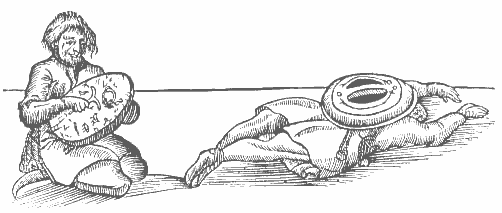Shamanism and European witchcraft

shaman beating his drum, and visited by devils in his trance

There has been considerable recent interest in the relationship between shamanism and witchcraft. In part, this has arisen from Carlo Ginzberg's work on the benandanti of the Friuli region of Northern Italy, translated as The Night Battles, and his more recent attempt, in Ecstasies, to trace the roots of the concept of the witches' sabbat by using the folklore techniques of the Soviet scholar, Vladimir Propp. In part, this interest has been aroused by the increasing awareness of the different patterns of belief and prosecution in Scandinavia, around the Baltic, and in Eastern Europe. Hungarian scholars, such as Gabor Klaniczay and Eva Pócs, have been especially active in promoting the position that the Indo-European tradition can be uncovered through the use of folklore and related to the trials.
The problem is that, by and large, it was not shamans that formed the bulk of those prosecuted in Russia, or Hungary, or Scandinavia. It may be that they were trusted by their clients, as were the cunning folk of Western Europe, who may be seen as their equivalents to some extent. It may be that their activities did not easily fit into the pattern of prosecutions familiar to the courts. Nevertheless, they were prosecuted in some regions, they were demonized in the few travellers' tales that were published about the European fringes during the period of the witch-hunts, just as the inhabitants of the New World were. It may be that the presence of shamans gave a particular character to prosecutions in the northern and eastern countries, providing a more masculine character to secret power, at least until the clergy and authorities were exposed to demonological literature from the rest of Europe.

An early example of the demonization of shamans is the geographical treatise of Olaus Magnus (1490-1558), who was made Catholic Archbishop of Uppsala in exile. His Historia de gentibus septentrionalibus ...(Rome, 1555) is divided into twenty-two books, the third of which is called "De superstitiosa cultura daemonum populorum aquilonarium". The entire work is profusely illustrated with woodcuts; those in Book Three show the northern peoples? special concern with the power of shamans over the sea and ships, their use of drums and trances, and their entanglement with demons.


The Devil
carrying a witch off to Hell.
The sorceror Gilbert shackled by the wizard Catillum
on the island of Weterlacus


Witch conjuring demons
Witch conjuring a storm


Shaman selling wind in knots to sailors
Sorcerer riding the waves on a whalebone
.


Lesser devils working for their sorcerors
Demons and satyrs cavorting
A LATER TRAVELLER'S TALES
There was a considerable market for tales of the Northern sorcerors and their superstitions. Pierre Martin de la Martinière published his travel accounts, Voyage des Pais Septentrionaux, in 1671. Subsequent editions contained additional material. The author was only 19 years old when he signed on as a ship's surgeon, in a fleet of three trading ships, in Copenhagen, early in May 1653.


Olaus Magnus (1490-1557), A compendious history of the Goths, Svvedes, & Vandals and other northern nations (London, 1658) available on microfilm: Early English books, 1641-1700; 541:1
Nathaniel Crouch's version of material in Johannes Scheffer's Lapponia, trans. as The History of Lapland wherein are shewed the original, manners, habits, marriages,conjurations, &c. of that people (Oxford, 1674) which is on microfilm: Early English books, 1641-1700; 438:08; 2019:13
Pierre Martin de La Martinière (1634-1690), A
new voyage into the northern countries being a discription of the manners,
customs, superstition, buildings, and habits of the Norwegians, Laponians,
Kilops, Borandians, Siberians, Samojedes, Zemblans and Islanders (London,
1674)
available on microfilm: Early English books, 1641-1700;
1288:9
Pierre Martin de La Martinière, A new voyage to the north...To which is added, a particular relation of the court of the Czar (London, 1706) available on microfilm: The Eighteenth Century; reel 3013, no. 6
Aado Lintrop, "Hereditary transmission in Siberian Shamanism and the concept of the reality of legends", Folklore, vol.1 (June 1996): Estonian electronic journal
Mare Kõiva, "The transmission of knowledge among Estonian Witch Doctors", Folklore, vol.2 (Dec. 1996)
Mihaly Hoppal, "Natur [sic] worship in shamanism", Folklore, vol. 4 (June 1997)
the case of the Lapp shaman, Aikie Aikiesson
Rune Hagen, "The Witches' Sabbath at Christmas Eve: Christmas Witchcraft in 17th-century Finnmark (Northern Norway)"
Rune Hagen, "The Shaman of Alta: The 1627 Witch Trial of Quiwe Baarsen"
More slight, but interesting, are his little sketches,
Rune Hagen, "Notions
of Sami Witchcraft", "Satan
in the North", "At
the Entrance to Hell"
More material in a website on Witchcraft, Magic and Witch Trials in Finland, written by Timo Kervinen and Marko Nenonen